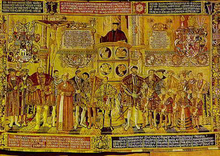- Maria of Saxony, Duchess of Pomerania
-
Maria of Saxony Duchess consort of Pomerania-Wolgast Tenure 27 February 1536–14 February 1560 Spouse Philip I, Duke of Pomerania Issue John Frederick, Duke of Pomerania
Bogislaw XIII, Duke of Pomerania
Ernst Ludwig, Duke of Pomerania
Barnim X, Duke of Pomerania
Margaret, Duchess of Saxe-Lauenburg
Anna, Duchess of Mecklenburg-Güstrow
Casimir VI, Duke of PomeraniaHouse House of Wettin Father John, Elector of Saxony Mother Margaret of Anhalt-Köthen Born 15 December 1515
WeimarDied 7 January 1583 (aged 67)
WolgastReligion Lutheranism Maria of Saxony (German: Maria von Sachsen; 15 December 1515, Weimar – 7 January 1583, Wolgast) was a member of the Ernestine line of the house Wettin and a Princess of Saxony by birth and by marriage a Duchess of Pomerania.
Contents
Life
Mary was the eldest daughter of the Elector John "the Steadfast" of Saxony (1468–1532) from his second marriage to Margaret of Anhalt-Köthen (1494–1521), daughter Prince of Waldemar VI of Anhalt-Zerbst.
She married on 27 February 1536 in Torgau Duke Philip I of Pomerania (1515–1560). The marriage of the couple is depicted on the so-called Croÿ Carpet, which shows, in addition to the bridal couple and their families, the Reformers Johannes Bugenhagen, Martin Luther and Philipp Melanchthon. The carpet comes from Cranach's workshop and is now in the Pomerania State Museum in Greifswald. During the ceremony, Martin Luther is reproted to have dropped one of the rings, whereupen and he said: "Hey, devils this is none none of your business!.[1]
The marriage of Philip with Maria was meant to ally to Pomerania with Saxony, which was leading the evangelical faction in the Diet. The marriage had been mediated by the Reformer Johannes Bugenhagen. Later that year, Pomerania joined the Schmalkaldic League.
After her husband's death Mary lived, who had been promised the district of the Pudagla as her Wittum, initially continued living at Wolgast Castle. In 1569, her son Ernest Louis, took over the business of government in the Duchy and granted her the income from the land of the former monastery Pudagla as jointure and in 1574, he built her Pudagla Castle using materials from the demolished monastery buildings.[2]
Issue
From her marriage with Philip, Maria had the following children:
- George (1540–1544)
- John Frederick I (1542–1600), Duke of Pomerania-Wolgast
- married in 1577 Princess Erdmuthe of Brandenburg (1561-1623)
- Bogislaw XIII (1544–1606), Duke of Pomerania-Barth
- married firstly, in 1572 Princess Claire of Brunswick-Lüneburg (1550-1598)
- married secondly, in 1601 Princess Anne of Schleswig-Holstein-Sonderburg (1577-1616)
- Ernest Louis (1545–1592)
- married in 1577 Princess Sophia Hedwig of Brunswick-Wolfenbüttel (1561-1631)
- Amalie (1547–1580)
- Barnim X (1549–1603), Duke of Pomerania-Rügenwalde
- married in Anna Maria of Brandenburg (1567-1618)
- Eric (1551-1551)
- Margaret (1553–1581)
- married in 1574 Duke Francis II of Saxe-Lauenburg (1547-1619)
- Anna (1554–1626)
- married in 1588 Duke Ulrich III of Mecklenburg-Güstrow (1528-1603)
- Casimir VI (1557–1605), bishop of Cammin
Ancestry
Ancestors of Maria of Saxony, Duchess of Pomerania 16. Frederick I, Elector of Saxony 8. Frederick II, Elector of Saxony 17. Catherine of Brunswick-Lüneburg 4. Ernest, Elector of Saxony 18. Ernest, Duke of Austria 9. Margaretof Austria 19. Cymburgis of Masovia 2. John, Elector of Saxony 20. Ernest, Duke of Bavaria 10. Albert III, Duke of Bavaria 21. Elisabetta Visconti 5. Elisabeth of Bavaria 22. Eric I, Duke of Brunswick-Grubenhagen 11. Anna of Brunswick-Grubenhagen-Einbeck 23. Elisabeth of Brunswick-Göttingen 1. Maria of Saxony 24. Sigismund I, Prince of Anhalt-Dessau 12. George I, Prince of Anhalt-Dessau 25. Judith of Querfurt 6. Waldemar VI, Prince of Anhalt-Köthen 26. Sigismund, Count of Hohnstein 13. Sophia of Hohnstein ? 3. Margaret of Anhalt-Köthen 28. Heinrich XXVI, Count of Schwarzburg-Blankenburg 14. Günther XXXVI, Count of Schwarzburg-Blankenburg 29. Elisabeth of Cleves, Countess of Schwarzburg-Blankenburg 7. Margaret of Schwarzburg-Blankenburg 30. William II, Count of Henneberg-Schleusingen 15. Margaret of Henneberg-Schleusingen 31. Katherine of Hanau-Münzenberg References and sources
- Horst Robert Balz, Gerhard Krause, Gerhard Müller: Theologische Realenzyklopädie, vol. 27, de Gruyter, Berlin, 1997, p. 44 (Digitized)
- Carola Jäggi, Jörn Staecker: Archäologie der Reformation, de Gruyter, Berlin, 2007, p. 355 ff (Digitized)
- Heinrich Karl Wilhelm Berghaus: Landbuch des Herzogthums Pommern und des Fürstenthums Rügen, vol. 1, Anklam, 1865, p. 544 (Digitized)
- This page is a translation of its German equivalent.
External links
External links
- ^ Jodócus Donatus Hubertus Temme: Die Volkssagen von Pommern und Rügen, Berlin 1840, p. 86
- ^ Dirk Schleinert: Die Geschichte der Insel Usedom, Hinstorff, Rostock, 2005, ISBN 3-356-01081-6, p. 67f
Categories:- Pomerania
- House of Wettin
- 1515 births
- 1583 deaths
- German nobility
Wikimedia Foundation. 2010.

